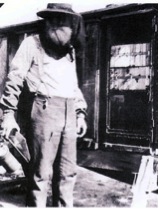John Stewart Harbison grew up in Freedom, PA where he learned the nursery trade from his father. In 1854, when a severe drought nearly ruined their business, it was time for a change. So, at the age of 28, John moved to California in search of gold. Well, prospecting didn’t suit him much so he decided to go back to what he knew –agriculture. But this time he would stay in California, opening his nursery in Sutterville.
John Stewart Harbison grew up in Freedom, PA where he learned the nursery trade from his father. In 1854, when a severe drought nearly ruined their business, it was time for a change. So, at the age of 28, John moved to California in search of gold. Well, prospecting didn’t suit him much so he decided to go back to what he knew –agriculture. But this time he would stay in California, opening his nursery in Sutterville.
Then in November 1869, John Harbison entered a contract with R.G. Clark in San Diego. Harbison would provide necessary supplies and teams of farm labor along with portable housing and transportation to San Diego County while Clark managed the field work and harvested the crop. Later that year, R.S. Pardee contacted Clark about some unexpected success he had with his produce in Lakeside. Well, Clark knew this would interest Harbison and convinced John to take a look at Pardee’s operation. Harbison came down for a few days to explore Pardee’s claim, then returned to Sutterville while Clark searched for the mysteriously sweet and spicy essence that made Pardee’s product superior. Clark later discovered that the local sages dotting the east county landscape provided the characteristics that uniquely distinguished Pardee’s goods.
This discovery, and the potential to produce the commodity in large quantities, convinced John Harbison to relocate with his wife, Mary, and their daughter, Florence, to a homestead along the Sweetwater River. Here, he started an industry that would make San Diego the leading producer of his elixir in the entire state. By 1873, they produced 30 tons of their product – much more than the West Coast markets could handle, so they began shipping boxcars of their goods to eastern consumers. Production at this level was so demanding, that many thousands of field workers were needed and two saw mills were busy most of the year just producing lumber for worker housing and production facilities.
John Harbison failed to strike gold in the mineral form, but his agricultural operations in San Diego County produced gold far beyond his dreams.
Oh, I didn’t tell you the most important thing – the name of his product, that back country elixir with the unique sweet and spicy taste so much desired by consumers West and East of the Continental Divide. Well that is our History Mystery question for April: What did John Harbison’s company produce in such quantities that he was recognized as America’s largest producer?
If you know the answer, send us a note to mystery@alpinehistory.org . Need help solving this one? Come visit us at the museum open house from 2 to 4 pm on Saturday, April 26 or Sunday, April 27, where docents will be on hand to help you solve this mystery. The museum is located at 2116 Tavern Road in Alpine.













